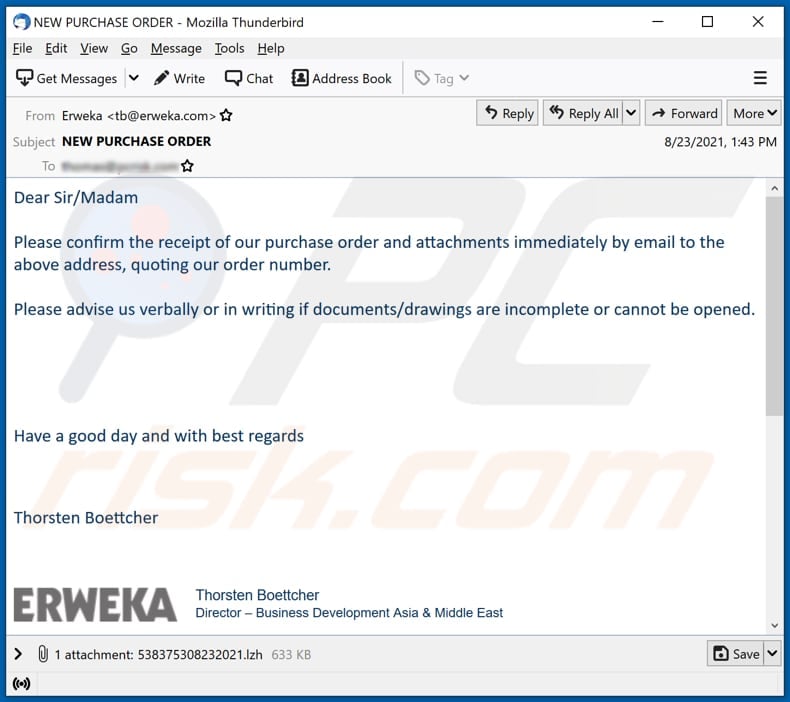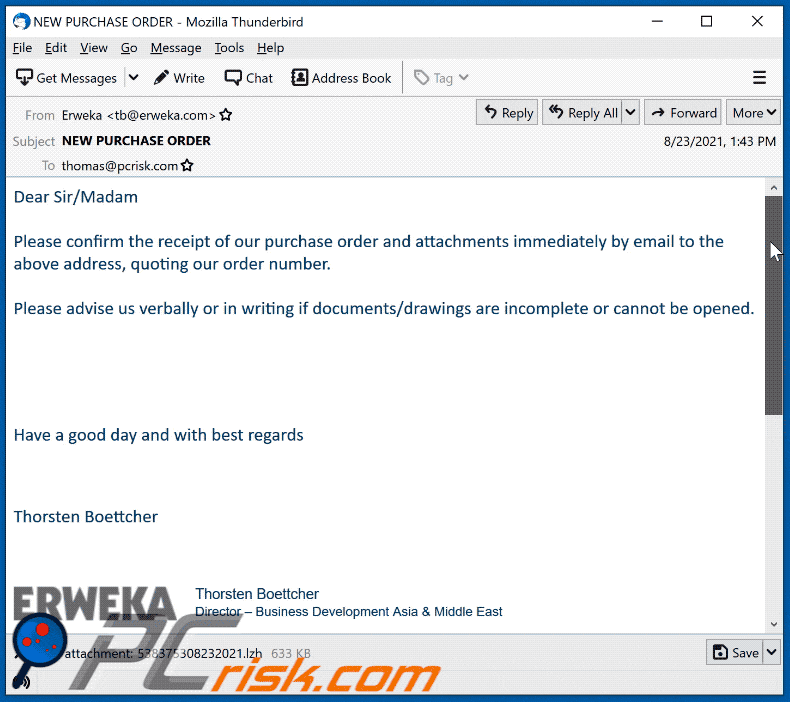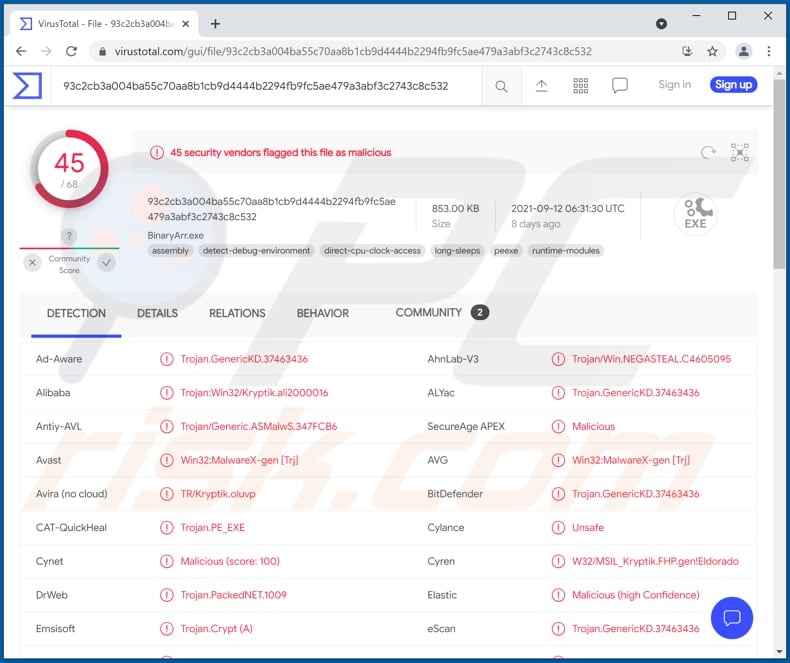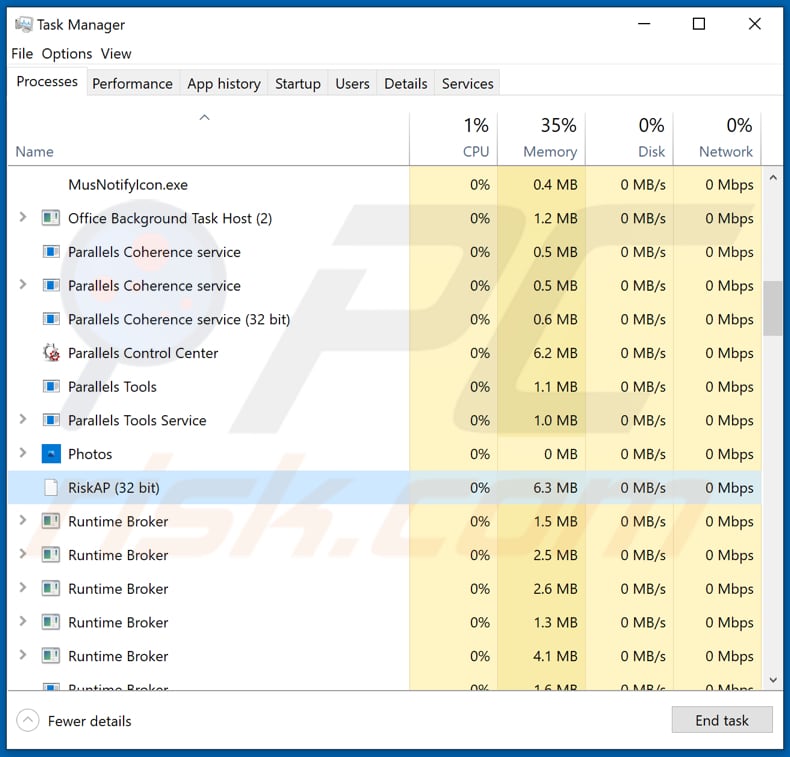Get free scan and check if your device is infected.
Remove it nowTo use full-featured product, you have to purchase a license for Combo Cleaner. Seven days free trial available. Combo Cleaner is owned and operated by RCS LT, the parent company of PCRisk.com.
What is Erweka email virus?
Emails used as a channel to distribute malware contain a malicious attachment or website link. Cybercriminals behind them pretend to be legitimate companies, organizations. Users infect computers after opening a malicious file. This email is used to deliver FormBook malware.

Erweka email virus in detail
Cybercriminals behind this malicious email attempt to trick recipients into believing that they have received a letter regarding a new purchase order. They encourage recipients to confirm the receipt of a purchase order - to open the attachment (a file named "538375308232021.lzh". Its name may vary).
That email attachment is an archive file that contains a malicious executable designed to install FormBook malware. FormBook can be used to take screenshots, steal clipboard data, login credentials saved in web browsers, record keystrokes (pressed keys). Also, it can be used to distribute other malicious software (for example, ransomware).
| Name | Erweka spam |
| Threat Type | Trojan, password-stealing virus, banking malware, spyware. |
| Hoax | The email attachment is a purchase order that needs to be reviewed |
| Attachment(s) | 538375308232021.lzh (its name may vary) |
| Detection Names (malicious executable in the attachment) | Avast (Win32:MalwareX-gen [Trj]), Combo Cleaner (Trojan.GenericKD.37463436), ESET-NOD32 (Win32/Formbook.AA), Kaspersky (HEUR:Backdoor.MSIL.Remcos.gen), Microsoft (Trojan:MSIL/AgentTesla.CMY!MTB), Full List Of Detections (VirusTotal) |
| Symptoms | Trojans are designed to stealthily infiltrate the victim's computer and remain silent, and thus no particular symptoms are clearly visible on an infected machine. |
| Payload | FormBook |
| Distribution methods | Infected email attachments, malicious online advertisements, social engineering, software 'cracks'. |
| Damage | Stolen passwords and banking information, identity theft, the victim's computer added to a botnet. |
| Malware Removal (Windows) |
To eliminate possible malware infections, scan your computer with legitimate antivirus software. Our security researchers recommend using Combo Cleaner. Download Combo CleanerTo use full-featured product, you have to purchase a license for Combo Cleaner. 7 days free trial available. Combo Cleaner is owned and operated by RCS LT, the parent company of PCRisk.com. |
Emails used to deliver malware in general
Most of the malicious emails are disguised as official, important letters from legitimate companies. More examples of similar emails are "Interhydro Email Virus", "Baldur Email Virus", and "Taxve Inc. Email Virus". Typically, cybercriminals attempt to trick recipients into thinking that the attached files, included links will open important documents.
How did "Erweka email virus" infect my computer?
Recipients install malware when they open a malicious Microsoft Office or PDF document, contents of the attached ZIP, RAR or another archive file, JavaScript file, executable file, or some other file. Malicious documents opened with MS Office 2010 and later versions cannot install malware without permission.
Those documents ask for permission to enable macros commands (editing or content). Users install malware when they enable macros commands. Older MS versions do not have the "Protected View" mode. Thus, malicious documents opened with them do not ask for any permission - they install malware automatically.
How to avoid installation of malware?
Installed software has to be updated and activated with tools that its developers provide. Received irrelevant emails containing website links or files should not be ignored (especially when such emails are sent from unknown addresses). Files and programs should be downloaded from official websites and via direct links.
The operating system should be scanned for threats with a reputable antivirus or anti-spyware software. It is highly advisable to keep the installed security suite up to date. If you've already opened "Erweka email virus" attachment, we recommend running a scan with Combo Cleaner Antivirus for Windows to automatically eliminate infiltrated malware.
Appearance of the Erweka malicious email (GIF):

Text presented in this email:
Subject: NEW PURCHASE ORDER
Dear Sir/Madam
Please confirm the receipt of our purchase order and attachments immediately by email to the above address, quoting our order number.
Please advise us verbally or in writing if documents/drawings are incomplete or cannot be opened.
Have a good day and with best regards
ERWEKA
Thorsten Boettcher
Director – Business Development Asia & Middle EastErweka Asia Pacific Ltd
A, 11/F., Man Lok Bldg.
93 Bonham Strand
Hong KongT: +852 2291 6300
F: +852 2291 6311tb@erweka.com
hxxp://www.erweka.comErweka Asia Pacific Ltd; Managing Director: Thorsten Bottcher; BR Reg No.:67128051-000-01-17-04
Malicious executable in the attached file detected as malicious in Virustotal:

FormBook running in Task Manager as "RiskAP" (its name may vary):

Instant automatic malware removal:
Manual threat removal might be a lengthy and complicated process that requires advanced IT skills. Combo Cleaner is a professional automatic malware removal tool that is recommended to get rid of malware. Download it by clicking the button below:
DOWNLOAD Combo CleanerBy downloading any software listed on this website you agree to our Privacy Policy and Terms of Use. To use full-featured product, you have to purchase a license for Combo Cleaner. 7 days free trial available. Combo Cleaner is owned and operated by RCS LT, the parent company of PCRisk.com.
Quick menu:
- What is Erweka spam?
- Types of malicious emails.
- How to spot a malicious email?
- What to do if you fell for an email scam?
Types of malicious emails:
![]() Phishing Emails
Phishing Emails
Most commonly, cybercriminals use deceptive emails to trick Internet users into giving away their sensitive private information, for example, login information for various online services, email accounts, or online banking information.
Such attacks are called phishing. In a phishing attack, cybercriminals usually send an email message with some popular service logo (for example, Microsoft, DHL, Amazon, Netflix), create urgency (wrong shipping address, expired password, etc.), and place a link which they hope their potential victims will click on.
After clicking the link presented in such email message, victims are redirected to a fake website that looks identical or extremely similar to the original one. Victims are then asked to enter their password, credit card details, or some other information that gets stolen by cybercriminals.
![]() Emails with Malicious Attachments
Emails with Malicious Attachments
Another popular attack vector is email spam with malicious attachments that infect users' computers with malware. Malicious attachments usually carry trojans that are capable of stealing passwords, banking information, and other sensitive information.
In such attacks, cybercriminals' main goal is to trick their potential victims into opening an infected email attachment. To achieve this goal, email messages usually talk about recently received invoices, faxes, or voice messages.
If a potential victim falls for the lure and opens the attachment, their computers get infected, and cybercriminals can collect a lot of sensitive information.
While it's a more complicated method to steal personal information (spam filters and antivirus programs usually detect such attempts), if successful, cybercriminals can get a much wider array of data and can collect information for a long period of time.
![]() Sextortion Emails
Sextortion Emails
This is a type of phishing. In this case, users receive an email claiming that a cybercriminal could access the webcam of the potential victim and has a video recording of one's masturbation.
To get rid of the video, victims are asked to pay a ransom (usually using Bitcoin or another cryptocurrency). Nevertheless, all of these claims are false - users who receive such emails should ignore and delete them.
How to spot a malicious email?
While cyber criminals try to make their lure emails look trustworthy, here are some things that you should look for when trying to spot a phishing email:
- Check the sender's ("from") email address: Hover your mouse over the "from" address and check if it's legitimate. For example, if you received an email from Microsoft, be sure to check if the email address is @microsoft.com and not something suspicious like @m1crosoft.com, @microsfot.com, @account-security-noreply.com, etc.
- Check for generic greetings: If the greeting in the email is "Dear user", "Dear @youremail.com", "Dear valued customer", this should raise suspiciousness. Most commonly, companies call you by your name. Lack of this information could signal a phishing attempt.
- Check the links in the email: Hover your mouse over the link presented in the email, if the link that appears seems suspicious, don't click it. For example, if you received an email from Microsoft and the link in the email shows that it will go to firebasestorage.googleapis.com/v0... you shouldn't trust it. It's best not to click any links in the emails but to visit the company website that sent you the email in the first place.
- Don't blindly trust email attachments: Most commonly, legitimate companies will ask you to log in to their website and to view any documents there; if you received an email with an attachment, it's a good idea to scan it with an antivirus application. Infected email attachments are a common attack vector used by cybercriminals.
To minimise the risk of opening phishing and malicious emails we recommend using Combo Cleaner Antivirus for Windows.
Example of a spam email:

What to do if you fell for an email scam?
- If you clicked on a link in a phishing email and entered your password - be sure to change your password as soon as possible. Usually, cybercriminals collect stolen credentials and then sell them to other groups that use them for malicious purposes. If you change your password in a timely manner, there's a chance that criminals won't have enough time to do any damage.
- If you entered your credit card information - contact your bank as soon as possible and explain the situation. There's a good chance that you will need to cancel your compromised credit card and get a new one.
- If you see any signs of identity theft - you should immediately contact the Federal Trade Commission. This institution will collect information about your situation and create a personal recovery plan.
- If you opened a malicious attachment - your computer is probably infected, you should scan it with a reputable antivirus application. For this purpose, we recommend using Combo Cleaner Antivirus for Windows.
- Help other Internet users - report phishing emails to Anti-Phishing Working Group, FBI’s Internet Crime Complaint Center, National Fraud Information Center and U.S. Department of Justice.
Frequently Asked Questions (FAQ)
Why did I receive this email?
Most cybercriminals send the exact same email to thousands of recipients hoping that someone will open a file or link in it. These malicious emails are never personal.
I have downloaded and opened a file attached to this email, is my computer infected?
If the opened file was an executable (for example, EXE/.exe file), then most certainly it has infected a computer. If it was a document (like PDF, DOC), then it is possible that a computer is safe. Pretty often, it is not enough to open a document. The opened document needs permission to enable macros commands or to do something else.
I have read the email but didn't open the attachment, is my computer infected?
No, opening an email by itself is completely harmless. Recipients infect computers after clicking on received website links or by opening malicious attachments.
Will Combo Cleaner remove malware infections that were present in email attachment?
Yes, Combo Cleaner is capable of detecting and eliminating almost all known malware infections. High-end malware can be capable of hiding deep in the operating system. Therefore, it is recommended to run a full system scan.
Share:

Tomas Meskauskas
Expert security researcher, professional malware analyst
I am passionate about computer security and technology. I have an experience of over 10 years working in various companies related to computer technical issue solving and Internet security. I have been working as an author and editor for pcrisk.com since 2010. Follow me on Twitter and LinkedIn to stay informed about the latest online security threats.
PCrisk security portal is brought by a company RCS LT.
Joined forces of security researchers help educate computer users about the latest online security threats. More information about the company RCS LT.
Our malware removal guides are free. However, if you want to support us you can send us a donation.
DonatePCrisk security portal is brought by a company RCS LT.
Joined forces of security researchers help educate computer users about the latest online security threats. More information about the company RCS LT.
Our malware removal guides are free. However, if you want to support us you can send us a donation.
Donate
▼ Show Discussion